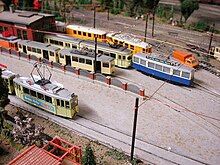Model tram

A model tram is a replica of a tram on a reduced scale in the model .
Similar to model railroaders, model tramways build a section of reality in a model. The focus of their systems is mostly on the replication of "city landscapes" and urban railways or regional rail routes.
Similar to the Faller Car System , model trams can also be found as a supplement to model railroad systems.
Compared to the classic model railway
The market for model trams is significantly smaller than that of classic model trains; Models are often only produced in small series. Plastic industrial models often reproduce the prototype in a greatly simplified manner and are sometimes given their detailing mainly through the printing. In contrast to locomotives, the models are not always provided with lighting and must be implemented by the model maker himself. The track material specially designed for trams (for example, for rails embedded in the road or the grooved rails typical of trams ) is also made by some model trams themselves. Some tram models are offered as a kit. While model railway locomotives are almost always motorized, the drive for trams is often optional - mostly there are drives that are tailored to the respective model, easy to install drives, but with some models the motorization also requires the model builder's craftsmanship. Due to the higher level of craftsmanship required, model construction and conversion is more pronounced than with model railways.
Like model trains, model trams are increasingly being controlled digitally ; Analog-controlled systems are often operated in overhead line operation in order to implement turning loops and track triangles without switching overhead . The gauges and the driving voltages correspond to those of the model railroad; IIm , H0 , H0m , N and Z are usually used as gauges , other nominal sizes are less common.
Model tram systems can be designed more realistically than model railroad systems, as narrow track radii and strongly curved points (as they often occur in model railroad systems) are also common in the prototype. In addition, prototypical train lengths are significantly shorter than with the model railroad. Example: A prototypical intercity train with typically eight cars is about 2.5 meters long in the nominal size H0, whereas even long trams are rarely longer than 50 cm. Light rail systems are in between in terms of their space requirements.
In order to achieve various Bauwünsche and because of the opportunity to work together to build larger systems and to drive, are also modular layouts found.
Manufacturer of model trams
One of the first manufacturers of model trams was the Hamo company , which offered a complete range of tracks and overhead lines. Later the company Gogtram from Ulm followed with toy tram models , Liliput with its models of the war tram car (KSW) and in the 1970s Rivarossi .
Active manufacturers today include the companies Leopold Halling (Vienna), Herrmann & Partner (Dresden), Beka (Dresden), Line 8 / Rietze (Bad Tölz / Altdorf) and Navemo (Zurich). Halling also produces some of the models for its competitors. Roco also offered different versions of the Cologne GT6 and GT8. For the nominal size N (1: 160) Faller / Tomytec supplies several tram models, including a three-part low-floor car in the colors of various German transport companies. N models are also available from the manufacturer Kato. The so-called souvenir models of the Vienna public transport company were very popular, but some were also kept quite simple. During the GDR era, VEB Prefo Dresden produced some plastic kits based on East German models, which are still available from Herrmann & Partner today. In the past few years, however, numerous other kits and finished models have been developed there, mainly based on the East German model. Models of Berlin trams from Epochs II to IV are offered by Fröwis-Modellbau.
Meanwhile, the companies Modellbahntechnik Hof and Luna-Tram / Tillig also offer ready-to-install track systems for model trams. In contrast to conventional model tracks, these tracks have no sleepers, but rather imitate a grooved track by replicating the road pavement or a layer of asphalt between the rails.
Events
Every year, model tram enthusiasts from Germany and neighboring countries meet for the Small Railway Big One exhibition . Model tram systems, models and literature from predominantly non-commercial exhibitors are shown in halls rented or made available for this purpose. Most of the time, the event takes place in cities with a tram, because local transport companies are there to provide support. For example, the events took place in a bus depot in Chemnitz and in a tram hall in Bremen and Schwerin . In 2016, however, the event had to move to a locomotive shed in Neumünster due to a lack of support from Hamburg . Small train really big is Europe's largest model tram event. An average of around 200 exhibitors take part in the events. In a few years up to 4,000 visitors could be counted. The last event took place in March 2020 in Braunschweig. A venue for the KBGG exhibition is missing for 2021 after plans in Vienna were terminated due to a lack of affordable premises.
There is also a TLRS meeting each in Nuremberg . Here, hobbyists show their models and systems, each with a different theme.
literature
- Matthias Vollstedt: Tram in a model , Alba publication, Düsseldorf, 2006, ISBN 3-87094-239-8 (2nd edition)
- Tram magazine , Geramond-Verlag, Munich Browse online
See also
- Museum tram
- List of publicly accessible model railways - including some "trams"
